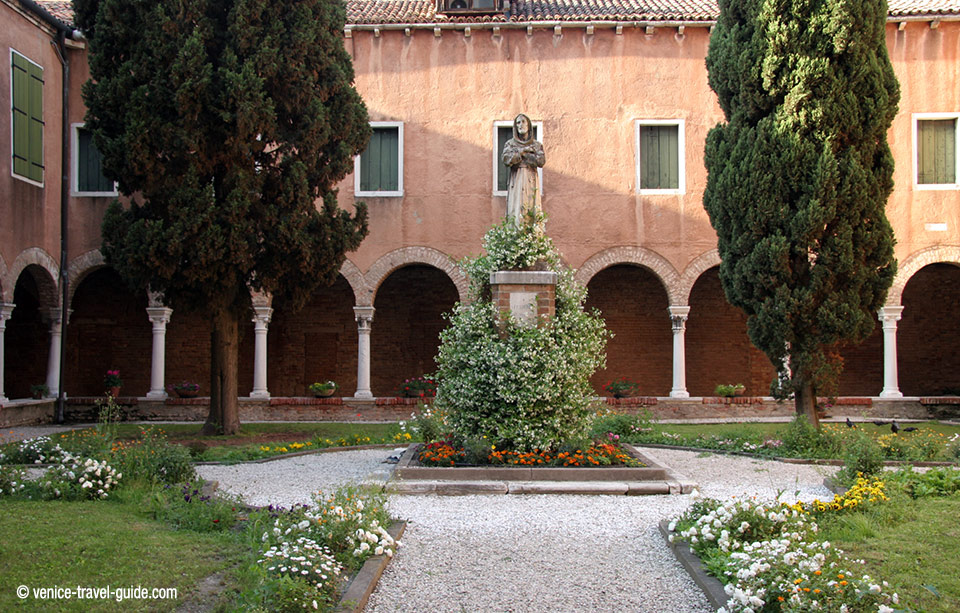San Francesco della Vigna is a church in the sestiere of Castello in Venice. Along with Santa Maria Gloriosa dei Frari, this is one of two Franciscan churches in Venice.
The church was designed in Renaissance style by Jacopo Sansovino. The facade of the church was ultimately commissioned from Andrea Palladio (1562) by Giovanni Grimani.
History
The site, originally a vineyard (Vigna), was donated by Marco Ziani in 1253 for construction of the monastery. A tiny chapel already on the site recalled the spot where an angel supposedly had pronounced Pax tibi Evangelista meus to the shipwrecked apostle St. Mark, patron of Venice.
The first church at the site was a triple-nave Gothic church by Marino da Pisa. A monastery housed the Frati Minori dell'Osservanza, while the Conventuali occupied the Frari across town. By the 16th century, the church building was in need of repair. Two main impulses led to the reconstruction of this church; one was the reform sweeping the order of the Franciscan Observants, and the other was the wishes of Doge Andrea Gritti, whose family palace neighbored the church. In 1534, this Doge laid the foundation stone for the new church. The nave was roofed over by 1554.
The church was designed in Renaissance style by Sansovino, with the advice of the Franciscan friar, Fra Francesco Zorzi. Fra Zorzi based the sizing of the various elements on the number three, because of its association with the Trinity: the nave should be nine paces wide and 27 paces long, each side chapel three paces wide.
Each chapel was sold for 200-350 ducats to aristocratic donors, raising much needed construction funds, granting the rights to place their coat-of-arms in the chapel and to bury their family there. For the right to be buried in the floor of the chancel in front of the high altar, Doge Andrea Gritti paid 1000 ducats. In 1542, Vettor Grimani and his brother Cardinal Marino acquired rights to build the facade for the church. The three sarcophagi for two cardinals and a patriarch from the Grimani family are no longer in place. The facade of the church was ultimately commissioned from Andrea Palladio (1562) by Giovanni Grimani.
Interior
The interior of the church has a simplicity and severity befitting a Franciscan church, with plain Istrian marble Doric pilasters. The choir, which in the past was occupied by the monks during services, is behind the altar. The interior contains an alabaster sculpture of St. Louis of Toulouse, and an early 15th-century Gothic painting of the Madonna of humility.
The Grimani chapel (first in the left aisle) is decorated with ceiling paintings by Battista Franco, and murals and altarpiece by Federico Zuccari. The chapel has been restored by the British charity Venice in Peril, which also restored Palladio's facade in the 1990s.
In the third chapel on the right are paintings by Francesco Fontebasso: Glory of St. Peter of Alcantara on the ceiling; on the walls: St. Peter of Alcantara and St. Teresa of Avila, St. Peter of Alcantara and Queen Isabella of Spain, The Death of St Peter of Alcantara and The Assumption of St Peter of Alcantara into Heaven. Also on the walls: two ovals, on the right the cardinal virtues Faith, Hope and Charity by Jacopo Marieschi and on the left, Religion and Meditation by Francesco Maggiotto. The decoration of the chapel was completed in 1789.
The third chapel to the left, with a dome, is the Sagredo chapel. It honors San Gherardo Sagredo (died 1046, canonized 1076), and is embellished with frescoes by Tiepolo and sculpture by Andrea Cominelli. It also has monuments to the Doge Niccoló Sagredo (reign 1675-1676) and Alvise Sagredo, both by Giovanni Gai. The spandrels are frescoed by Tiepolo with the four evangelists. The dome has a sotto in su fresco by Gerolamo Pellegrini. The chapel underscores the complex machinations in an oligarchic and aristocratic Venice to uphold the family name.
The church also houses a chapel of the Barbaro family containing the Barbaro ancestral arms, a red circle on a white field, granted in the 12th century after Admiral Marco Barbaro was victorious in Jaffa.
Map of San Francesco della Vigna Church


